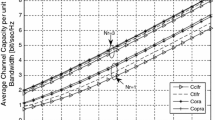Abstract
Based on the imperfect estimation information, the performance analysis of multi-input multi-out (MIMO) systems with rate-adaptive modulation and space–time coding over flat Rayleigh fading channels is presented in this paper. The fading gain value is partitioned into a number of regions by which the modulation is adapted according to the region the fading gain falls in. Under a target bit error rate (BER) and constant power constraint, the fading gain region boundaries are given. By utilizing the minimum mean squared error estimation, the correlation between the channel gains and their estimates, which contributes to imperfect channel information, is evaluated. With this correlation, the probability density function of fading gain is obtained. Based on these results, the closed-form expressions for the SE and average BER are derived in detail, respectively. The theoretical expressions will be more accurate than the existing schemes, and they include perfect estimation as a special case. Numerical results show that the SE and BER of the system with imperfect estimation are worse than those with perfect estimation due to the estimation error. Moreover, the simulation results for SE and BER are in good agreement with the theoretical analysis.
Similar content being viewed by others
References
Goldsmith A. J., Chua S. G. (1997) Variable-rate variable-power MQAM for fading channel. IEEE Transactions on Communications 45(10): 1218–1230
Choi B., Hanzo L. (2003) Optimum mode-switching-assisted constant-power single-and multicarrier adaptive modulation. IEEE Transactions on Vehicular Technology 52: 536–559
Alouini M.-S., Goldsmith A. J. (2000) Adaptive modulation over nakagami fading channels. Wireless Personal Communications 13: 120–143
Chung S. T., Goldsmith A. J. (2001) Degrees of freedom in adaptive modulation: A unified view. IEEE Transactions on Communications 49: 1561–1571
Shin H., Lee J. H. (2004) Performance analysis of space–time block codes over keyhole Nakagami-m fading channels. IEEE Transactions on Vehicular Technology 53(2): 351–362
Tarokh V., Jafarkhani H., Calderbank R. (1999) Space–time block coding for wireless communications: Performance results. IEEE Journal on selected areas in communications 17: 451–460
Sandhu S., Paulraj A. J. (2000) Space–time block codes: A capacity perspective. IEEE Communications Letters 4(12): 384–386
Maaref, A., & Aïssa, S. (2004). Rate-adaptive M-QAM in MIMO diversity systems using space–time block codes. In Proceeding of IEEE PIMRC’, pp. 2294–2298.
Carraro, H. M., Fonollosa, R. J., & Delgado-Penin, A. J. (2004). Performance analysis of space–time block coding with adaptive modulation. In Proceeding of IEEE PIMRC’, pp. 493–497.
Jiangbo, D., Yongzhou, Z., & Daoben, L. (2003). Combined adaptive modulation & coding with space–time block code for high data transmission. In Proceeding of IEEE ICCT’03, pp. 1476–1479.
Femenias G. (2004) Adaptive SR-ARQ combined with STBC in Markov channels. Electronics Letters 40(6): 377–378
Proakis J. G. (2001) Digital communications, (Chaps. 2–5) (4th ed.). McGraw-Hill, New York
Gans M. J. (1971) The effect of Gaussian error in maximal ratio combiners. IEEE Transactions on Communication Technology COM-19(4): 492–500
Tomiuk B. R., Beaulieu N. C., Abu-Dayya A. A. (1999) General forms for maximum ratio diversity with weighting error. IEEE Transactions on Communications 47(4): 488–492
Gradshteyn I. S., Ryzhik I. M. (2000) Table of Integrals, Series, and Products (Chaps. 8–9) (5th ed.). Academic, San Diego, CA
Simon M. K., Hinedi S. M., Lindsey W. C. (1995) Digital Communication Techniques Signal Design and Detection (Chaps. 4 and 10). Prentice-Hall, Englewood Cliffs, NJ
Stamoulis A., Diggavi S. N., Al-Dhahir N. (2002) Intercarrier interference in MIMO-OFDM. IEEE Transactions on Signal Processing 50: 2451–2464
Kay S. M. (1993) Fundamentals of statistical signal processing: Estimation theory, (Chap. 12). Prentice-Hall, Englewood Cliffs, NJ
Author information
Authors and Affiliations
Corresponding author
Rights and permissions
About this article
Cite this article
Yu, X., Leung, S.H. Performance Analysis of Rate-Adaptive Modulation with Imperfect Estimation in Space–Time Coded MIMO System. Wireless Pers Commun 57, 181–194 (2011). https://doi.org/10.1007/s11277-009-9851-8
Published:
Issue Date:
DOI: https://doi.org/10.1007/s11277-009-9851-8




